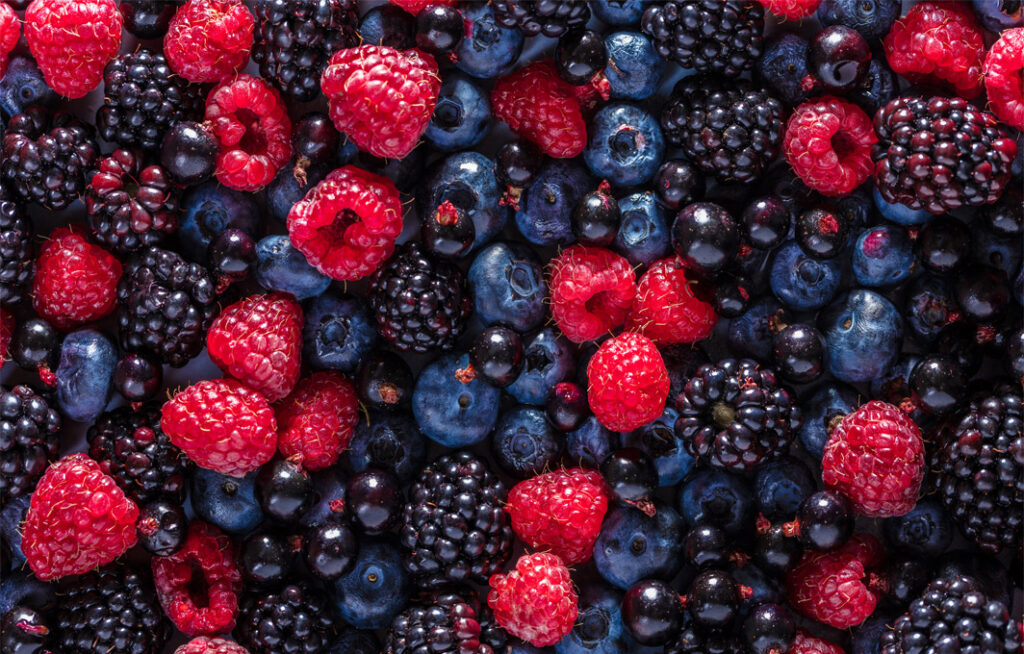Fruit on keto – do you eat it? If yes, which ones?

Late spring and summer is a time of delicious, juicy fruit. We eagerly reach for the fresh strawberries, plums or cherries available everywhere. Seasonal, forest fruits such as raspberries and blueberries go well in cakes, desserts and cocktails, while treats with fresh berries are so rare that we sometimes find it hard to resist. Although fruit is a rich source of micronutrients and vitamins, a ketogenic diet involves limiting the daily intake of carbohydrates, and therefore most fruit. However, some of them can be indulged in. Want to know which fruits you can eat when on the keto diet and which ones to beware of? In what quantities should you eat them so that you don’t break the rules of the keto diet, while still enjoying their delicious taste and properties? Be sure to read our article, in which we answer these and other questions you are sure to ask yourself during the summer season.
Which fruits are best on the keto diet?
On the one hand, fruit is an excellent source of vitamins and has the nutritional values necessary for the body to function properly, but on the other hand, most of them contain carbohydrates, which you should practically give up during the keto diet. How to deal with this? The key is to eat low-carbohydrate fruits. These are mainly berries – strawberries, raspberries, blueberries, blackberries. In addition, it is worth reaching for avocados and tomatoes. Yes, these are fruits too! And they contain plenty of nutrients, such as potassium, zinc and iron, as well as omega-3 and omega-6 acids, which are extremely important on a high-fat diet.
What are the best keto fruits? Among the most recommended are those that have the least net carbohydrates, that is, those counted after subtracting the fibre. For example, 100g of raspberries contain only 5.5 grams of net carbohydrates and 100g of strawberries are 5.7 grams of net carbohydrates. Watermelon can be controversial on a keto diet, as it is high in carbohydrates and low in fibre, but you should also remember that it is mostly made up of water. So you can indulge in a small amount of watermelon from time to time.
9 nutritious keto-friendly fruits
Including low-carbohydrate fruits in a ketogenic diet would undoubtedly increase its nutrient density. Eating the fruits listed below provides a healthy mix of vitamins, minerals and fibre while maintaining a state of ketosis.
Avocado
Avocados are almost synonymous with the ketogenic diet. With its low net carbohydrate content and high fat content, it is an absolute powerhouse of nutrients. It is full of heart-healthy monounsaturated fats, fibre and key nutrients such as potassium and vitamin K. A typical medium-sized avocado consists of 80 calories, 8 grams of carbohydrates and 6 grams of fibre.
Coconut
Coconut, although not usually considered a fruit, is actually one, and a rather keto-friendly one at that. Coconuts are rich in fat and fibre, which contribute to feelings of satiety and curb hunger. A piece of coconut (approximately 15g) contains approximately 0.9 grams of net carbohydrates.
Olives
Often forgotten in the fruit category, the distinctive olives play an important role in the ketogenic diet. Rich in healthy monounsaturated fats, vitamin E and other powerful antioxidants, olives are low in carbohydrates, fitting in perfectly with the keto philosophy. A serving of 10 green olives (about 25g) contains about 0.4 grams of net carbohydrates and 0.6 grams of fibre.
Berries
Looking for a little sweetness as part of your keto diet? Berries, particularly strawberries, blueberries, raspberries and blackberries, are the best choice. Berries are known for their high fibre, antioxidant content and relatively lower net carbohydrate levels compared to other fruits. For example, raspberries and blackberries contain 3.7 and 6.2 grams of net carbohydrates per handful, respectively.
Cucumbers
Cucumbers are refreshing, nutritious and undeniably keto-friendly. Consisting mainly of water, cucumbers are very low in carbohydrates. They are a good source of vitamin K and can be a great addition to a salad or as a snack with hummus. Half a long cucumber (approximately 90g) contains just 2.1 grams of net carbohydrates.
Tomatoes
Tasty, versatile and perfect for a balanced ketogenic diet, tomatoes are packed with many beneficial nutrients, including vitamin C and potassium. They also contain the antioxidant lycopene, which has been linked to numerous health benefits. Interestingly, cooking tomatoes in olive oil can maximise lycopene absorption. One medium tomato contains approximately 2.6 grams of net carbohydrates.
Watermelon
Watermelons can be eaten in moderation on a ketogenic diet. Watermelon is a hydrating fruit that is full of vitamins A and C. It is ideal for summer BBQ side dishes or as a natural post-workout treat to help replenish electrolytes. A slice of watermelon (approximately 150g) contains 12.1 grams of net carbohydrates and 0.5 grams of fibre.
Fruit on keto
Still, it is important to remember that fruit cannot be eaten too much on a ketogenic diet. What is the safe limit? The recommended maximum amount is half a glass of fruit per day and such a portion will not affect the effects of the ketogenic diet.
Dried fruit on keto
Is it okay to eat dried fruit on a ketogenic diet? This is quite a tricky question as they are of course much healthier than typical sweets, however, when dried, the sugar levels in them increase. This makes it best to avoid them when on a keto diet. Instead of dried fruit, reach for coconut shavings! Coconuts are one of the most preferred fruits on the keto diet due to their low carbohydrate content. They can be eaten raw and fresh. They contain a lot of healthy fats and are an ideal addition to many dishes.
Why should you not eliminate fruit?
Fruit on keto provides the body with a range of different micronutrients such as folic acid, vitamins, dietary fibre and polyphenols. You can find vitamin C in strawberries, raspberries and blackberries. It is essential for collagen synthesis and promotes the absorption of non-haem iron. Berries contain antioxidants and avocados are a source of vitamin K, which is involved in blood clotting. In addition, you will find beta carotene, or provitamin A, in the fruit. This substance is counted among the powerful antioxidants and has a beneficial effect on the condition of mucous membranes and skin colour. Although they cannot be consumed in excess, they should definitely not be eliminated either.
The importance of fibre
Adequate intake of fibre can protect our body from diseases such as type II diabetes, atherosclerosis and hypertension. Fibre helps to maintain a healthy body weight, has a beneficial effect on lipid and carbohydrate metabolism, and improves bowel function. According to the recommendations of the World Health Organisation (WHO) and the European Food Safety Authority (EFSA), the daily intake of fibre should be around 25 grams. Fruits that provide the most of it and are also allowed on a ketogenic diet are strawberries and avocados.
Which fruits to avoid on a ketogenic diet?
During the ketogenic diet, certain fruits cannot be eaten due to their negative effects on weight reduction and thus on the entire diet.
Above all, you should not eat on keto:
- dried fruits,
- bananas,
- mangoes,
- dates,
- grapes.
They are particularly rich in carbohydrates and simple sugars. Too many carbohydrates have a direct effect on weight gain and thus on unnecessary kilos. Only those who train can afford them in small quantities.
Fruit on the ketogenic diet – how often can you eat it?
The ketogenic diet consists of eating foods containing carbohydrates and protein in limited quantities and instead opting for those containing healthy fats. What fruit to eat in a state of ketosis? Fresh plums can be eaten in small quantities. These fruits are particularly recommended at the beginning of the state of ketosis and keto adaptation and can help with digestive complaints. In addition, lemons should be included from time to time during the ketogenic diet. They contain pectin, a type of fibre that helps to stabilise blood sugar levels, furthermore fights inflammation and prevents the formation of cancer cells.
Ideas for using fruit on the keto diet
How can you use fruit on the keto diet? On our website you will find examples of simple and tasty recipes using fruits such as strawberries, blueberries or avocados. Fancy ice cream or pancakes? Add blueberries or raspberries for a tasty and nutritious snack that won’t break your diet.
Use avocados and tomatoes! Although more associated with vegetables, biologically they are fruits. A medium-sized avocado contains only 5 grams of net digestible carbohydrates, and as much as 30 grams of fat. Although it is not sweet, it can be a healthy addition to pastes, smoothies or salads. Tomatoes are also welcome on the ketogenic diet. Around 200 grams of the fruit contains 5 grams of carbohydrates. It is also an excellent source of potassium – an ingredient that is worth supplementing during a low-carbohydrate diet.
It is worth remembering that fruit also includes processed foods such as jams, marmalades, compotes and syrups. Of course, any products with added sugar are out of the question on a ketogenic diet, but there are healthy substitutes, such as Keto Very Strawberry Jam™. This is a premium product made from fresh strawberries! It is vegan, gluten-free, natural and completely sugar-free. Also among the recommended products is Keto Jam™ Super Raspberry. It will work great as a sandwich or cake topping. Just remember that even healthy substitutes need to be eaten in moderation. Try not to exceed 1/3 jar per day.
What else can you eat on a ketogenic diet?
If you’re wondering what additional foods are allowed on the keto diet, you’re cordially invited to read our comprehensive post keto diet – what can I eat. There you will discover a full list of recommended products, enriched with descriptions and practical advice. This knowledge will help you compose varied and appetising meals, supporting your health goals. Don’t hesitate to delve into the valuable information we have gathered especially with you in mind!


